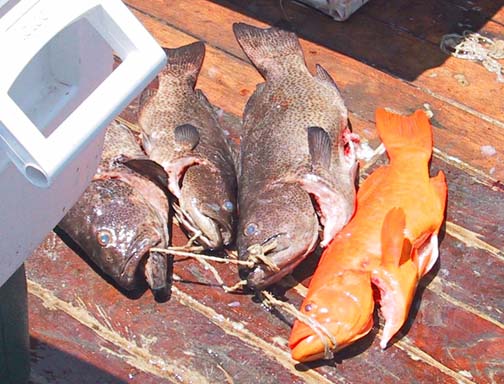
Midriff Islands Species Safari
![]()
|
MIDAS TOUCH--Why do they do it? Nobody knows. At left, three normally colored leopard grouper, or "cabrilla," and at right, an example of the one percent, or so, that suddenly turn a garibaldi orange to become a "golden grouper" or "golden cabrilla." Photo courtesy Derek Yen. |
FISHING FOR A VARIETY OF SPECIES ON THE SEA OF CORTEZ
By Gene Kira, July 21, 2003, as published in Western Outdoor News:
Next week, I'm planning to float around the Midriff Islands, Sea of Cortez, Mexico, aboard Tony Reyes' San Felipe panga mothership, the Jose Andres.
And I can almost guarantee there'll be a great big grin on my face. I love the whole rustic deal of these Midriff motherships: showering in my fishing clothes and having dinner while I dry off, sleeping on the outside bunks with my little fan plugged in, and most of all, stumbling into my panga every morning with a whole new set of islands to explore.
|
|
This year, I'm not planning to mess with yellowtail or cabrilla very much, except by "accident." Instead, I'm taking a low-gear-ratio reel loaded with Spectra, and a bunch of different sinkers, leaders, rockcod flies, Lucky Joe rigs, and circle hooks, and the game will be to catch and photograph as many different species as possible in a single, six-day trip.
To help pump up the catch list for this "Species Safari," I'll also take the usual "ton-o'-jigs," MirrOLures, and of course, Jointed Rebels, but this time, they'll take a back seat to the deep bait-and-feather fishing, from about 300 feet on down, where the weird stuff hangs out.
Unfortunately, the Mexican biologist-photographer who was scheduled to go on this trip had to cancel at the last minute, so we'll have to rely on my crummy photos for the more exotic species identifications, and we won't be bringing back any specimens preserved in alcohol (except for possibly a client or two).
That will have to wait for next year's safari, when I'm hoping we can go down with a whole boat load of anglers on the quarter moon to fish Mexico's Midriff Islands for species--with a biologist along to sort things out "scientifically." It's sure to be a fascinating experience, because this remarkable area has the Cortez' most complex and profound topography and most complicated currents and temperature gradients. For species, the Midriff is a rich and still-mysterious zoo.
|
|
This year, for instance, there seem to be an unusual number of "golden grouper" being caught. This brilliantly-colored fish, looking just as vivid as our Pacific Coast garibaldi, is also called a "golden cabrilla," and it's really not a separate species, but a rare color variation of the plain old olive-drab-brown leopard grouper (which Mexicans call "cabrilla"), Mycteroperca rosacea.
There are many stories--including some famous ones by Western Outdoor News' original Baja Editor, Ray Cannon--but so far I've never heard a convincing explanation for why a very small percentage of these "cabrilla," or leopard groupers should suddenly turn a solid, day-glow orange over their entire bodies.
Very rarely, you will catch a "golden grouper" in the process of changing colors, or perhaps they "get stuck" halfway through the process. Anyway, both of the fish I've seen in this condition had a bright orange rear end and regular coloration on the front, with a very sharp boundary line in between.
Another interesting color shift is with the giant jawfish, or "bigmouth bastard" (the fish's official name, recorded by Dr. Boyd W. Walker of UCLA in the 1950s), Opisthognathus rhomalea. Usually, these fish are a regular, almost undefinable creamy brown inside the mouth, but sometimes they turn a solid, bright yellow in there. Perhaps it has to do with their spawning season.
Another thing is eels. In the Midriff you bring up all kinds of strange ones that are not in the popular books.
The list goes on and on, of course, and that's something to respect and treasure. Almost for sure, there will be sightings that can't be explained, and plenty of mysterious big yankers that break us off and are never seen, and that's all part of this excellent game.
(Related Bahia de los Angeles (L.A. Bay) articles and reports may be found at Mexfish.com's main Bahia de los Angeles (L.A. Bay). See weekly fishing news, photos, and reports from the major sportfishing vacation areas of Mexico including the Bahia de los Angeles (L.A. Bay) area in "Mexico Fishing News.")
MEXICO FISHING INFO BAHIA DE LOS ANGELES FISHING INFO "WEEKLY MEXICO FISHING NEWS" FISH PHOTO GALLERY
